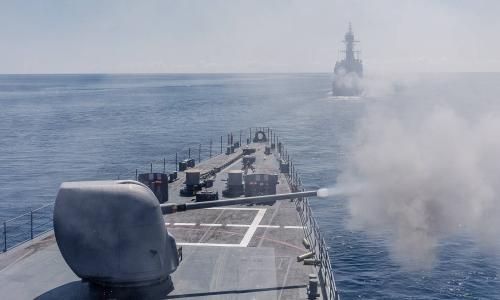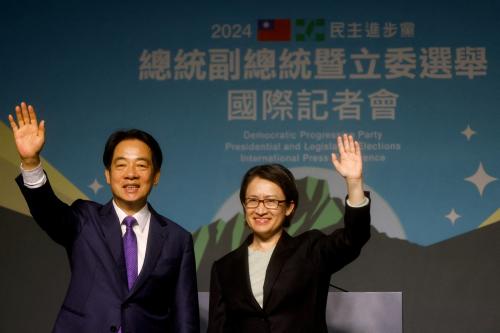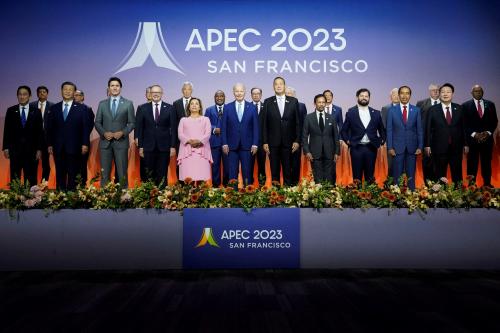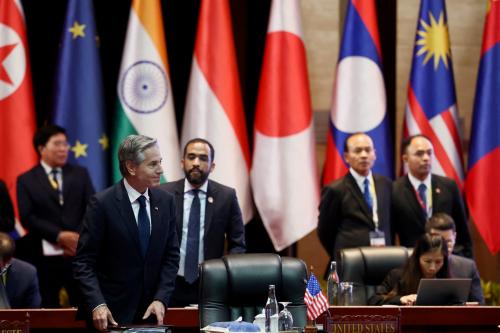The United States’ security partnership with Taiwan is unusual. Washington does not recognize the Republic of China (ROC) government in Taipei as the government of China, but instead recognizes the People’s Republic of China (PRC) in Beijing. It conducts substantive ties with Taiwan through a nominally private organization, the American Institute in Taiwan. Still, America has a security partnership with Taiwan. The bond is broad and deep but quite complex. The next administration will need to manage this partnership carefully in the context of Beijing’s relationships with Washington and Taipei.
China poses two different dangers to Taiwan
Beijing seeks to incorporate Taiwan into the PRC, and its People’s Liberation Army (PLA) poses a military danger to Taiwan. The PLA possesses an array of military capabilities to project power against the island. It can subject Taiwan to various limited attacks, such as missile and air bombardment. However, the U.S. Department of Defense judges that what Taiwan most fears—an amphibious invasion—is currently beyond the PLA’s reach.
Taiwan faces a second danger: “coercion without violence,” a PRC campaign to bring Taiwan to heel short of war. This began after the 2016 election of Tsai Ing-wen, the leader of the Democratic Progressive Party (DPP), which Beijing believes is determined to turn Taiwan into a separate country. (In fact, the island’s leaders understand that “Taiwan independence” would provoke a PLA attack and that voters strongly prefer the status quo.) To subdue Taiwan without running the risks of war, the PRC is using economic, political, judicial, diplomatic, informational, cyber, and “gray zone” military tactics. Unlike war, which would target Taiwan’s armed forces, “coercion without violence” seeks to deplete the confidence of the people and eventually induce capitulation to PRC terms.
Thus, Beijing has developed two different means—military and coercive—to achieve its political objective of unification. Both are serious challenges to the island’s security and the U.S.-Taiwan partnership. But each is different, and each requires a different response and a different division of labor. But both require the resolve of Taiwan leaders and the public, plus a capable military to enhance deterrence. The U.S. commitment to the island’s security remains critical.
Seven partnership issues
Taiwan’s vulnerabilities raise issues for the bilateral partnership.
1. What defense strategy should Taiwan employ to blunt a full-scale PLA attack and hopefully deter it?
Should Taiwan adopt a conventional defense on and over the Taiwan Strait or an asymmetric defense that severely complicates an amphibious landing? For over a decade, the United States has believed that the PLA’s modernization has rendered a conventional defense of Taiwan virtually impossible. But that is the option that Taiwan’s military leadership has preferred.
The strategy Taiwan chooses has two important implications. One is whether and how Taiwan can hold on long enough against an attack to give the U.S. armed forces time to intervene robustly, should the president order it. The second is what kinds of equipment Taiwan’s military should acquire from America, given limits. On both counts, Washington has believed that asymmetric defense works to Taiwan’s advantage by exploiting the PLA’s weaknesses.
2. Has Taiwan mobilized sufficient resources to deter war?
Washington has long urged Taiwan to proportionately spend to meet the military danger. Yet from 2013-2022, defense’s share of Taiwanese government expenditures only grew from about 11% to 12% (education and social welfare drew 45.6% in 2022). Over the same period, the absolute amount expanded by 50.2%, about 5% annually. Much of that goes to pay for expensive weapons platforms from the United States and to fund a volunteer army. Concerning personnel, the military’s authorized number of active-duty billets is only 188,000, less than 1% of the population. Building larger stockpiles of food, petroleum, ammunition, spare parts, and so on would strengthen Taiwan’s endurance.
3. How should Washington and Taipei calibrate their policies to minimize the risk that Chinese leaders decide that war is their only option?
The key is that any Taiwan administration, especially a DPP one, demonstrates it has no intention to pursue de jure independence, which is not easy because Beijing sometimes misperceives Taipei’s intentions and Taiwan political dynamics. But the line Tsai adopted during her presidency—“We must not yield to [PRC] pressure but should also not advance rashly because of [U.S.] support”—is worthy of emulation. Three other factors will likely encourage William Lai’s administration to exercise restraint. First, its main priorities are domestic, especially regaining the support of younger people. Second, the public understands that if Taiwan provoked a PLA attack, Washington would be less likely to defend the island. Third, Washington-Taipei mutual trust and communication are good, which facilitates careful policy coordination.
4. In order to deter a PRC attack, should the United States strengthen deterrence by stating an absolute, public commitment to come to Taiwan’s defense, as some have argued?
Probably not. Whether and how the United States intervenes in a Taiwan conflict depends on how it started, which cannot be known in advance. Also, public policy statements are not the only way Washington can express deterrent resolve. Private, detailed warnings at the highest level can convey clarity quite effectively.
5. How can America support Taiwan in coping with coercion without violence?
First, it can help Taiwan reduce vulnerabilities to PRC tactics. For example, Taiwan needs to strengthen its defenses against cyberattacks, an area where the United States has expertise. As Taiwan companies “de-link” from China’s market, the Biden administration has sought to improve U.S.-Taiwan economic relations. Second, the United States has been much more public than previously about its actions to support Taiwan. The purpose: to counter Beijing’s effort to undermine Taiwan psychologically. Clearly, however, bolstering public confidence is primarily the job of Taiwan’s leaders.
6. Does Taiwan have a more conciliatory option for China policy, one that will induce PRC restraint?
Ma Ying-jeou’s first term (2008-2012) suggests it does. Ma offered assurances about his intentions that Beijing found acceptable. Under Hu Jintao’s leadership, the PRC pursued a gradualist policy toward Taiwan that focused on improving economic relations and people-to-people ties. Yet it still urged Ma to begin political talks, which he spurned.
Although people in Taiwan might welcome a return to the engagement of the early Ma days, the prospects are not favorable. China’s market is not as attractive to Taiwan companies as it was in 2008. Taiwan voters would have to elect a non-DPP president (which last happened in 2012). Beijing would likely seek stronger assurances from that president than it accepted from Ma. It might insist on beginning political talks early on and that Taiwan accept unification as their ultimate goal.
7. What will be the impact of the U.S. elections on the U.S.-Taiwan-PRC triangle?
There are many variables at play, and any prediction would be informed speculation at best. For example, in a second Trump administration, who would hold the key positions? What are their detailed views about how to meet the PRC’s threats to Taiwan? How will power and decisionmaking be organized, especially the role of Trump, whose support for Taiwan is weak? Which party will control the House and the Senate? In the first Trump administration, decisionmaking was disorganized and there was conflict among its Taiwan policies.
My best but highly qualified guess is for a scenario of continuity. China will certainly continue coercion without violence, but at what level is not yet clear. It will continue to test Washington in East Asia. A Harris administration is likely to replicate the policies of the Biden administration regarding Beijing’s military and coercive threats, including close communication with Taiwan, material and psychological support, and urging China to show restraint. A second Trump administration will likely resemble the first: disorganized with contradictory tendencies and rhetorical inconsistency.







Commentary
Why does the US security partnership with Taiwan matter?
September 16, 2024